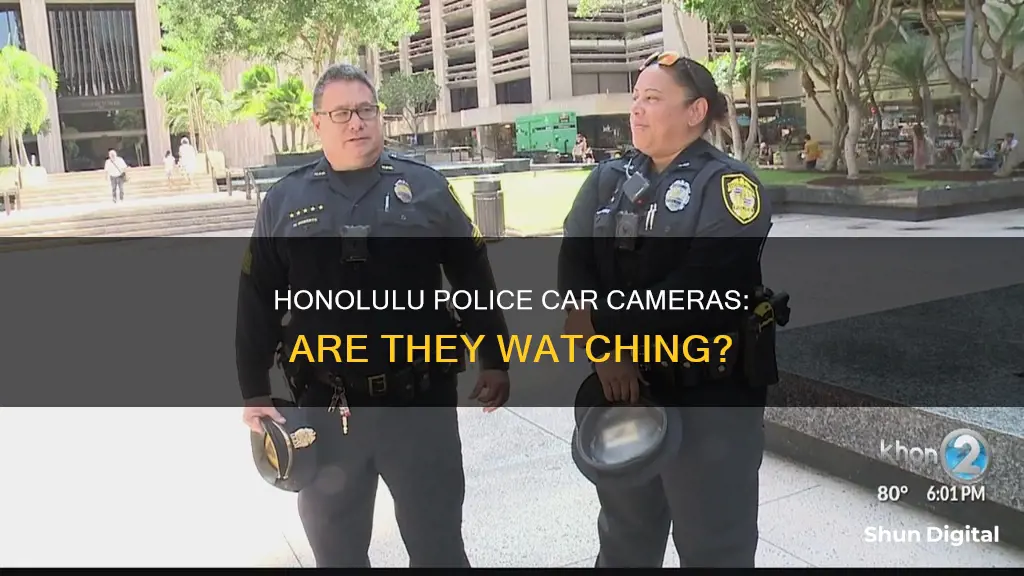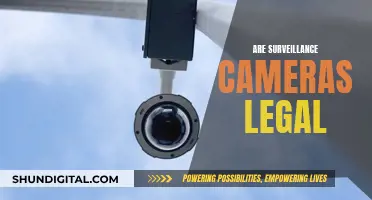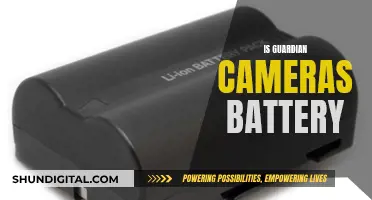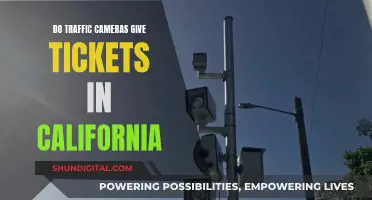
The Honolulu Police Department (HPD) is the principal law enforcement agency serving the island of O'ahu and its over 900,000 residents. In 2018, the HPD began equipping its officers with body cameras, following in the footsteps of other large urban departments. However, as of 2022, Honolulu police cars do not have dashboard cameras installed. While the HPD has guidelines for the use of body-worn cameras during vehicle pursuits, there is no mention of built-in vehicle cameras in their pursuit policy.
| Characteristics | Values |
|---|---|
| Do Honolulu police cars have cameras? | No |
| Honolulu police body cameras | Officers are required to turn their cameras on when responding to a call or initiating an encounter with a member of the public |
What You'll Learn

Honolulu police cars do not have dash cams
In Honolulu, police cars do not have dash cams, and this has been a source of contention for many citizens. The absence of this basic accountability measure has significant implications for criminal cases and police misconduct investigations. Honolulu's police officers have a history of being rarely fired for misconduct, and the lack of dash cam footage makes it challenging to verify the accuracy of their reports.
The Honolulu Police Department (HPD) has a long and troubled history. It has faced years of costly settlements due to officer-related lawsuits and has been under scrutiny for corruption and conspiracy. In recent years, there have been calls for increased transparency and accountability within the department. Despite this, HPD has been resistant to change and has failed to implement dash cams in their patrol cars.
The impact of not having dash cam footage is far-reaching. Without visual evidence, it becomes a matter of he-said-she-said, making it difficult for police commissioners to substantiate citizen allegations. This situation often leaves judges and juries with the challenging task of deciding whose story to believe without being able to see the encounter for themselves.
The lack of dash cams also affects criminal investigations. Video evidence can be critical in providing clarity after intense situations, capturing a suspect committing a crime, or documenting an officer accused of using excessive force. In many cases across the nation, footage has contradicted or challenged the initial police department narrative, highlighting the essential role of dash cams in ensuring police accountability.
While HPD officers are required to wear body cameras, the absence of dash cams in police cars creates a gap in the visual record of police interactions with the public. This gap can have serious consequences for all involved and undermines efforts to improve transparency and restore trust in the Honolulu Police Department.
Glo Bus Camera Game: Strategies for Focused Success
You may want to see also

Honolulu police officers are required to wear body cameras
In 2018, the Honolulu Police Department (HPD) began equipping its officers with body cameras, with the aim of improving transparency and accountability. The HPD has faced scrutiny for its secretive past and costly settlements in officer-related lawsuits. Body cameras are expected to provide clarity during intense situations, such as capturing a suspect committing a crime or an officer accused of using excessive force.
The HPD's body-worn camera (BWC) policy requires officers to activate their cameras whenever they respond to a call or initiate an encounter with the public. However, there have been concerns and criticisms regarding the consistent use of these cameras. Some officers have been found to turn their cameras off prematurely or fail to turn them on at all. This has led to discussions about increasing penalties for body camera violations and improving supervision to ensure proper camera usage.
The HPD's BWC policy categorises violations as minor infractions, resulting in light punishments such as counselling or written reprimands. Critics argue for harsher penalties, such as suspensions, to emphasise the importance of proper camera usage. There are also concerns about the department's policy forbidding supervisors from conducting random checks of camera footage. This restriction limits the ability to ensure officers are following the BWC rules.
While the HPD has invested in body cameras for its officers, there is separate information indicating that Honolulu police vehicles are not equipped with dashboard cameras. A person inquiring about the presence of dash cams in police cars was informed by a police officer that they do not have them. This information is further supported by a lawyer's confirmation that, to their knowledge, police vehicles in Honolulu do not have dashboard cameras.
In summary, while Honolulu police officers are required to wear body cameras, there is a separate discussion about the consistent usage of these cameras and the consequences for violations. Additionally, it is worth noting that the presence of dashboard cameras in police vehicles is a separate matter, and according to the available information, Honolulu police cars do not have dash cams.
Adjusting Axis P3346 Cameras for Optimal Focus
You may want to see also

Honolulu police officers do not always turn on their body cameras
Honolulu Police Department (HPD) officers are required by policy to turn on their body cameras whenever they respond to a call or initiate an encounter with a member of the public. However, there have been instances where officers have failed to activate their cameras or turned them off prematurely. This has raised concerns among police commissioners and the public, as body camera footage is crucial for providing transparency and accountability in police interactions.
In 2021, Honolulu police commissioners expressed alarm over the absence of footage in certain cases, highlighting the need for all officers to adhere to body camera protocols. The HPD's internal affairs office conducts random inspections of body camera usage, but these are limited to only 10 cases per month. When violations are identified, the current HPD policy categorizes them as minor infractions, resulting in light punishments such as divisional counseling or a written reprimand. However, critics argue that more stringent penalties, such as suspensions, may be necessary to deter officers from deliberately failing to record their encounters.
The lack of body camera footage can have significant implications for investigations into police misconduct and criminal cases. It can hinder the ability to substantiate complaints against officers and leaves judges and juries without crucial evidence when assessing conflicting accounts from police and defendants. In the case of the shooting of Lindani Myeni, for example, one of the three responding officers failed to activate their body camera, leading to unanswered questions about the incident.
To address this issue, the HPD has implemented several measures. They are exploring online and annual training to reinforce the importance of body camera usage and providing training to recruits on the use of cameras. Additionally, the HPD's cameras are equipped with signal devices that can be installed in patrol cars, automatically activating the body cameras when officers open their doors or turn on their lights and sirens. However, these devices were not in use until recently.
Despite these efforts, there is still room for improvement. Former Kauai Police Chief Darryl Perry, who pioneered body camera usage in Hawaii, emphasized the need for more stringent consequences for failing to activate body cameras. He suggested that supervisors should be granted the authority to conduct random checks on body camera compliance. Perry's concerns are echoed by Police Commissioner Doug Chin, who warned that without stronger deterrents, officers might be incentivized to turn off their cameras before engaging in inappropriate behavior.
In conclusion, while the HPD has made strides towards increasing body camera usage, there is a consensus that more needs to be done to ensure consistent activation by officers. Stricter penalties, improved training, and enhanced supervisory oversight are among the suggested measures to address this issue and promote transparency and accountability in police interactions with the public.
The First Camera: Joseph Niépce's Invention
You may want to see also

Honolulu police officers can use their own vehicles for work
In Honolulu, police officers can use their own vehicles for work through the "subsidized vehicle program". This program allows officers to use privately owned automobiles for police service, with the department covering insurance and equipment (lights and sirens) and providing a subsidy for "wear and tear".
The Honolulu Police Department (HPD) has a list of approved vehicles for this program, which includes specifications such as a wheelbase of no less than 100 inches, engines with a minimum of four cylinders, and gasoline engines only. The HPD dispenses 89-octane-level gasoline for all subsidized vehicles.
Officers may propose vehicles to be added to the approved list, but they must meet certain standards and specifications. For example, vehicles with racing-associated parts or models that take longer than ten seconds to accelerate from 0 to 60 mph are prohibited.
The use of personal vehicles by police officers in Honolulu is just one example of how law enforcement agencies adopt different tactics to manage their resources and address budgetary constraints. In some cases, departments may allow officers to take their patrol cars home, while in other instances, there may not be enough funds to purchase official police cars, requiring officers to use their own vehicles.
While the use of personal vehicles by Honolulu police officers can provide benefits in terms of cost savings and flexibility, it is important to note that "badass cars" like sports cars or vehicles with high-performance modifications are not typically permitted for this purpose. The approved vehicles for the HPD's subsidized vehicle program include models such as the Toyota 4Runner, which are more suitable for everyday police duties.
In recent years, the HPD has also invested in body-worn cameras for its officers, with a focus on improving transparency and accountability. This initiative, which began in 2018, aims to provide a more complete record of interactions between officers and the public, reducing confrontations and improving the quality of investigations.
PTZ Surveillance Cameras: Pan, Tilt, Zoom Security Explained
You may want to see also

Honolulu police vehicles have blue lights and sirens
In the state of Hawaii, there are various types of emergency vehicles, including police cars, fire trucks, and ocean safety officers. These vehicles have identifying markers and lighting that help the public recognize them and know when to give way.
Hawaii's police car lighting laws are unique because they do not have a statewide police agency or any individual city police agencies. Instead, they leave jurisdiction and regulation to individual counties. County law enforcement vehicles are among the only vehicles permitted to use blue emergency lights within the state of Hawaii. Statute 291-31.5 authorizes this.
Most police cars within Hawaii will have blue and red flashing police lights on the top of the car. Some may also have blue police lights installed along their tail lamps or headlamps. Cars may use any combination of blue and red, blue and white, or plain blue flashing lights. These vehicles must be authorized and approved by the chief of police for the county in which the vehicle operates before they can use blue lights.
Honolulu police vehicles are equipped with blue lights and sirens. The blue rooftop light is to be mounted and illuminated during on-duty hours, with a few exceptions. For instance, at the discretion of watch commanders, patrol vehicles operating in certain localities under special circumstances need not have the blue identification light illuminated. Additionally, the blue light should be turned on when the vehicle is stopped or parked at the scene of a traffic collision or during any traffic stop. When a blue light is used, the vehicle's hazard warning lights should also be turned on to enhance traffic safety for the officer or vehicle.
The use of sirens is also outlined in the Honolulu Police Department's policies. The flashing blue lights and siren shall be turned on when responding to an emergency call or initiating and engaging in a motor vehicle pursuit.
Lithium Camera Batteries: How Long Do They Really Last?
You may want to see also







